|
|
|
Sort Order |
|
|
|
Items / Page
|
|
|
|
|
|
|
| Srl | Item |
| 1 |
ID:
079657
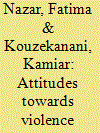

|
|
|
| 2 |
ID:
121130
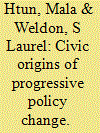

|
|
|
|
|
| Publication |
2012.
|
| Summary/Abstract |
Over the past four decades, violence against women (VAW) has come to be seen as a violation of human rights and an important concern for social policy. Yet government action remains uneven. Some countries have adopted comprehensive policies to combat VAW, whereas others have been slow to address the problem. Using an original dataset of social movements and VAW policies in 70 countries over four decades, we show that feminist mobilization in civil society-not intra-legislative political phenomena such as leftist parties or women in government or economic factors like national wealth-accounts for variation in policy development. In addition, we demonstrate that autonomous movements produce an enduring impact on VAW policy through the institutionalization of feminist ideas in international norms. This study brings national and global civil society into large-n explanations of social policy, arguing that analysis of civil society in general-and of social movements in particular-is critical to understanding progressive social policy change.
|
|
|
|
|
|
|
|
|
|
|
|
|
|
|
|
| 3 |
ID:
111803
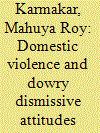

|
|
|
| 4 |
ID:
184993
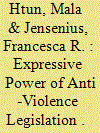

|
|
|
|
|
| Summary/Abstract |
We know more about why laws on violence against women (VAW) were adopted than about how much and in what ways these laws affect society. The authors argue that even weakly enforced laws can contribute to positive social change. They theorize the expressive power of VAW legislation, and present evidence for a cautiously optimistic assessment of current trends on violence against women and the ways that VAW laws affect social norms. Focusing on a time of major legal change related to VAW in Mexico, this article explores trends in behavior and attitudes related to violence by analyzing four waves of the National Survey on the Dynamics of Household Relations (ENDIREH), which include detailed interviews with thousands of Mexican women. The authors find that over this period, the share of women experiencing intimate-partner abuse declined, attitudes condoning violence shifted, reporting rates rose, and most women learned about legislation to protect their rights. These changes are consistent with the authors’ expectations about the expressive power of anti-violence legislation.
|
|
|
|
|
|
|
|
|
|
|
|
|
|
|
|
| 5 |
ID:
157780


|
|
|
|
|
| Summary/Abstract |
Many studies have looked into domestic violence but very few have considered women’s knowledge and perception about their rights. This study aims to examine the main sociocultural factors behind domestic violence against women with an emphasis on the power of the knowledge and perception of the women about their international and constitutional rights. Quantitative data collected in 2015 in the regions of East and Southwest Burkina Faso is used in this paper. Multivariate logistic regression is implemented to take into consideration the net effects of each factor when controlling the effects of other covariates. Results of this paper can be used to implement actions against domestic violence in the zone of intervention of the Program of Sexual Health and Human Rights project.
|
|
|
|
|
|
|
|
|
|
|
|
|
|
|
|
| 6 |
ID:
171116
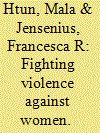

|
|
|
|
|
| Summary/Abstract |
In the 1990s and 2000s, pressure from feminist movements and allies succeeded in pushing scores of states to reform their laws to prevent and punish violence against women (VAW). Even in states with progressive legislation, however, activists face challenges to induce citizens to comply with the law, compel state authorities to enforce the law, and ensure the adequate allocation of resources for social support services. In this essay, we take stock of legislative developments related to VAW around the world, with a focus on the variation in approaches toward intimate partner violence and sexual harassment. We analyze efforts to align behavior with progressive legislation, and end with a discussion of the balance activists must strike between fighting VAW aggressively with the carceral and social support dimensions of state power, while exercising some restraint to avoid the potentially counterproductive effects of state action.
|
|
|
|
|
|
|
|
|
|
|
|
|
|
|
|
| 7 |
ID:
112539
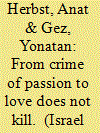

|
|
|
|
|
| Publication |
2012.
|
| Summary/Abstract |
This study examines the actions of the Na'amat women's organization and its allies in Israel, vis-à-vis the court and the press, in the legal-feminist struggle to fight violence against women. Using the 1991 murder of Einav Rogel by her ex-boyfriend Gilad Shemen as a case study, we argue that, in the public debate following the murder, Na'amat and its associates helped to overturn a prevalent press narrative. Specifically, their campaign tackled misleading press representations, such as use of the term "crime of passion". This accomplishment is framed within concerted efforts, since the 1970s, to turn the issue of violence against women into a comprehensive public problem that requires special attention by authorities.
|
|
|
|
|
|
|
|
|
|
|
|
|
|
|
|
| 8 |
ID:
145927
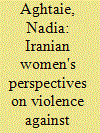

|
|
|
|
|
| Summary/Abstract |
This study explores the perspectives of female Iranian students living in both Iran and the UK concerning violence against women. A qualitative approach, in the form of in-depth interviews, was carried out with 21 participants. Drawing on Stark's concept of “liberty crime” the research found that the participants, regardless of their country of residence, perceived violence against women (VAW) as denying the opportunity for equal personhood by stripping away the victim's sense of self. However, the scope of what was considered to be liberty crime was affected by the individual participants’ religious beliefs and their degree of acceptance of the Iranian state's gender ideology. The research highlighted the extent to which different forms of VAW are interlinked and combine in order to control and subjugate women irrespective of their country of residence.
|
|
|
|
|
|
|
|
|
|
|
|
|
|
|
|
| 9 |
ID:
192542
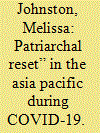

|
|
|
|
|
| Summary/Abstract |
COVID-19 has disrupted social, economic and political life across the Asia Pacific region, with particularly deleterious impacts on women. Rather than equitably affecting all, COVID-19 has brought about a “patriarchal reset”, exacerbating women’s health and care labour burdens and heightening the physical violence against women and other threats to women’s human rights. This paper examines global health governance in the region from a feminist political economy perspective. We ask how has the pandemic and associated lockdowns affected women’s safety and access to economic resources and services on the one hand, and ‘women, peace and security’ (WPS) practitioners’ capacity to safeguard women’s rights in fragile settings on the other hand? We examine the gendered impacts of COVID-19 based on two surveys of WPS practitioners during 2020. Significant rises in domestic and gender-based violence, reduced access to reproductive health services, and increased income insecurity were all perceived and/or experienced during COVID-19 restrictions. WPS practitioners delivered services to mitigate these effects of COVID-19 despite overall less funding than before COVID-19. With the benefit of primary data, we explore how a more radical approach is needed to understand and transform gender relations in light of gender-based violence and depletion of women’s labour.
|
|
|
|
|
|
|
|
|
|
|
|
|
|
|
|
| 10 |
ID:
184784
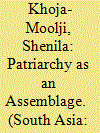

|
|
|
|
|
| Summary/Abstract |
This article contributes to recent debates about nuancing the idea of ‘patriarchy’ by drawing on Deleuze and Guattari’s notion of assemblage. It provides an account of patriarchy as a contingent yet persistent effect of human and material interactions wherein some molar forces aggregate and territorialise social relations around specific notions of womanhood, while molecular flows evade them. The particular set of interactions that this paper considers are configured through and around Qandeel Baloch, a social media celebrity from Pakistan, who was asphyxiated by her brother in 2016. In life, Baloch evaded several normative boundaries prescribed for middle-class Pakistani women. Riding the wave of social media expansion and an attentive youthful audience, she monetised male lust by transforming her body into a commodity, challenged self-appointed arbiters of religion, and mocked politicians. In death, she has been re-territorialised by mainstream media to conform to the social codes that bolster male domination. At the same time, she has been de-territorialised by feminist collectives that have produced their own normativity (or molarity) by erasing Baloch’s ambiguities and pronouncing her a feminist icon. Examining patriarchy as an assemblage of forces directs our attention to such heterogenous, even contradictory, movements wherein some pathways—male domination—are more heavily trafficked than others.
|
|
|
|
|
|
|
|
|
|
|
|
|
|
|
|
| 11 |
ID:
178127


|
|
|
|
|
| Summary/Abstract |
In Latin America and Southern Africa, norms on violence against women have developed with ups and downs, not simply in reaction to global norms, but sometimes even preceding global norm diffusion or surpassing it in terms of scope, framing and binding character. The classic global-to-local account with a single source of norm creation cannot capture these dynamics. Including the regional level in a dynamic model of norm diffusion enables us to understand the changing contents of a norm and to acknowledge transregional agency. We show (1) how norm contestation is an ongoing, multidirectional and polycentric process; (2) how the regional level opens up opportunities for feminists and femocrats; and (3) under which conditions regional norms can be both more progressive than global ones and more adapted to regional needs, and, in turn, are thus able to strengthen the ‘global’ norm.
|
|
|
|
|
|
|
|
|
|
|
|
|
|
|
|
| 12 |
ID:
170757
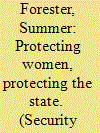

|
|
|
|
|
| Summary/Abstract |
Contrary to our understanding of when states act on women’s rights, Jordan adopted a policy on violence against women at the same time as it faced a number of external and internal security threats. In this article, I query the relationship between militarism and the gender policymaking process in Jordan to make sense of this puzzle. I specifically consider the ways in which a feminist conceptualization of militarism offers a more fruitful understanding of government action on violence against women in Jordan than studying this policy development through the lens of patriarchy, state institutions, and/or feminist activism alone. Indeed, evaluating the development of Jordan’s Family Protection Law through the lens of militarism and related security practices reveals the depth and breadth of these phenomena: the martial values and priorities of the Jordanian regime extend beyond the realm of traditional, ‘high politics’ security issues and impact civil, social, and even interpersonal relations – relations that are always already gendered – that are seemingly far removed from military concerns. I argue that the Jordanian government adopted its policy on violence against women because this enhanced the state’s image in the international arena and appeased domestic audiences by adhering to a gendered logic of protection that maintains the state as the ultimate protector of women. Overall, the article deepens our understanding of how militarism and the security climate influence the gender policymaking process, particularly in semi-authoritarian regimes.
|
|
|
|
|
|
|
|
|
|
|
|
|
|
|
|
| 13 |
ID:
088311
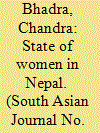

|
|
|
| 14 |
ID:
077303
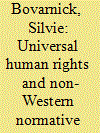

|
|
|
| 15 |
ID:
109114
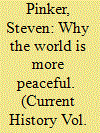

|
|
|
| 16 |
ID:
189700
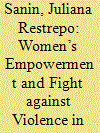

|
|
|
|
|
| Summary/Abstract |
Rates of gender-based violence in Latin America are high, but so is the number of women in national parliaments. This article analyzes that apparent paradox, paying attention to feminist and women’s rights mobilization in the region, the role of women in politics, and the development of legislation to address violence against women. Despite a comprehensive reshaping of the legal landscape, there are significant challenges to the implementation of these laws, including violence against women in politics. But feminist transnational activism continues to call for action.
|
|
|
|
|
|
|
|
|
|
|
|
|
|
|
|
| 17 |
ID:
169040
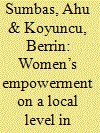

|
|
|
|
|
| Summary/Abstract |
Moving from the assumption that local governments are significant stakeholders of women’s empowerment policies, this article aims to examine the struggle against violence against women (VAW) at the local level through gender-sensitive policies employed by female mayors from a gender perspective and how these can be utilized as collective transformative resources for women’s empowerment. Based on a field-study, the contention of this article is that gender budgeting, gender-sensitive collective-labor contracts, and women’s support centers are institutional resources for the transformation of the municipal-budget, for attitude transformation in male employees, and for sustainable empowerment policies in the struggle against VAW in municipalities in Turkey. This article, stressing the link between the struggle against VAW and women’s empowerment, reveals the significance of institutionalization of gender-sensitive policies and the struggle at local level as two prominent factors taken to be into consideration in women’s empowerment.
|
|
|
|
|
|
|
|
|
|
|
|
|
|
|
|
|
|
|
|
|